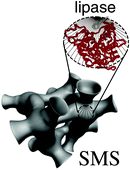Immobilization of lipase on silicas. Relevance of textural and interfacial properties on activity and selectivity
Abstract
Two lipases from Mucor miehei have been immobilized by

* Corresponding authors
a
Laboratoire de Matériaux Catalytiques et Catalyse en Chimie Organique, UMR 5618 CNRS-ENSCM-UM1, Institut C. Gerhardt FR 1878, Ecole Nationale Supérieure de Chimie de Montpellier, 8 rue de l’Ecole Normale, France
E-mail:
anne.galarneau@enscm.fr
Two lipases from Mucor miehei have been immobilized by

 Please wait while we load your content...
Something went wrong. Try again?
Please wait while we load your content...
Something went wrong. Try again?
A. Galarneau, M. Mureseanu, S. Atger, G. Renard and F. Fajula, New J. Chem., 2006, 30, 562 DOI: 10.1039/B517104K
To request permission to reproduce material from this article, please go to the Copyright Clearance Center request page.
If you are an author contributing to an RSC publication, you do not need to request permission provided correct acknowledgement is given.
If you are the author of this article, you do not need to request permission to reproduce figures and diagrams provided correct acknowledgement is given. If you want to reproduce the whole article in a third-party publication (excluding your thesis/dissertation for which permission is not required) please go to the Copyright Clearance Center request page.
Read more about how to correctly acknowledge RSC content.
 Fetching data from CrossRef.
Fetching data from CrossRef.
This may take some time to load.
Loading related content
